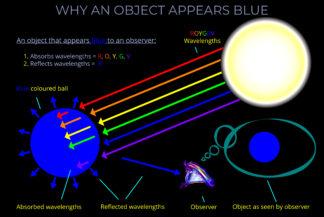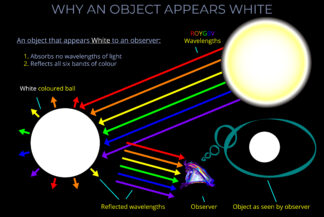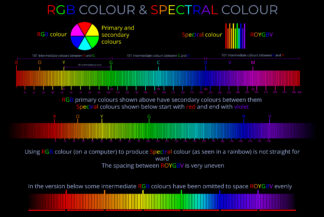How to See a Rainbow
£0.00
This is one of a set of almost 40 diagrams exploring Rainbows.
Each diagram appears on a separate page and is supported by a full explanation.
- Follow the links embedded in the text for definitions of all the key terms.
- For quick reference don’t miss the summaries of key terms further down each page.
Description
How to See a Rainbow
TRY SOME QUICK QUESTIONS AND ANSWERS TO GET STARTED
About the diagram
An overview of rainbows
Conditions for seeing rainbows
About the diagram
Some key terms
Rainbow colours are the colours seen in rainbows and in other situations where visible light separates into its different wavelengths and the spectral colours corresponding with each wavelength become visible to the human eye.
- The rainbow colours (ROYGBV) in order of wavelength are red (longest wavelength), orange, yellow, green, blue and violet (shortest wavelength).
- It is the sensitivity of the human eye to this small part of the electromagnetic spectrum that results in our perception of colour.
- The names of rainbow colours are a matter more closely related to the relationship between perception and language than anything to do with physics or scientific accuracy. While the spectrum of light and the colours we see are both determined by wavelength, it’s our eyes and brains that turn these differences in light into the colours we experience.
- In the past, rainbows were sometimes portrayed as having seven colours: red, orange, yellow, green, blue, indigo and violet.
- Modern portrayals of rainbows reduce the number of colours to six spectral colours, ROYGBV.
- In reality, the colours of a rainbow form a continuous spectrum and there are no clear boundaries between one colour and the next.
A rainbow is an optical effect produced by illuminated droplets of water. Rainbows are caused by reflection, refraction (bending) and dispersion (spreading out) of light in individual droplets and result in the appearance of an arc of spectral colours.
- Atmospheric rainbows only appear when weather conditions are ideal and an observer is in the right place at the right time.
- Waterfalls, lawn sprinklers and other things that produce air-borne water droplets can produce a rainbow.
- An atmospheric rainbow is formed from countless individual droplets each of which reflects and refracts a tiny coloured image of the Sun towards the observer.
- As white light passes through water droplets, refraction causes the light to disperse and separate into the different colours seen by an observer.
- If the sun is behind an observer then the rainbow will appear in front of them.
- When a rainbow is produced by sunlight, the angles between the sun, each droplet and the observer determine which ones will form part of the rainbow, the colour each droplet will produce and the sequence in which they appear.
- The observer effect is a principle of physics and states that any interaction between a particle and a measuring device will inevitably change the state of the particle. This is because the act of measurement itself imposes a disturbance on the particle’s wave function, which is the mathematical description of its state.
- The concept of observation refers to the act of engaging with an electron or other particle, achieved through measuring its position or momentum.
- In the context of quantum mechanics, observation isn’t a passive undertaking, observation actively alters a particle’s state.
- This means that any kind of interaction with an atom, or with one of its constituent particles, that provides insight into its state results in a change to that state. The act of observation is always intrusive and will always change the state of the object being observed.
- It can be challenging to reconcile this with our daily experience, where we believe we can observe things without inducing any change in them.
A human observer is a person who engages in observation by watching things.
- In the presence of visible light, an observer perceives colour because the retina at the back of the human eye is sensitive to wavelengths of light that fall within the visible part of the electromagnetic spectrum.
- The visual experience of colour is associated with words such as red, blue, yellow, etc.
- The retina’s response to visible light can be described in terms of wavelength, frequency and brightness.
- Other properties of the world around us must be inferred from light patterns.
- An observation can take many forms such as:
- Watching an ocean sunset or the sky at night.
- Studying a baby’s face.
- Exploring something that can’t be seen by collecting data from an instrument or machine.
- Experimenting in a laboratory setting.
An observer perceives bands of colour when visible light separates into its component wavelengths and the human eye distinguishes a series of distinct adjacent colours.
- The human eye and brain together translate light into colour.
- When rain disperses sunlight and forms a rainbow, an observer will typically distinguish red, orange, yellow, green, blue and violet bands of colour.
- Although a rainbow contains electromagnetic waves with all possible wavelengths between red and violet, some ranges of wavelengths appear more intense to a human observer than others.
Sunlight, also known as daylight or visible light, refers to the portion of electromagnetic radiation emitted by the Sun that is detectable by the human eye. It is one form of the broad range of electromagnetic radiation produced by the Sun. Our eyes are particularly sensitive to this specific range of wavelengths, enabling us to perceive the Sun and the world around us.
- Sunlight is only one form of electromagnetic radiation emitted by the Sun.
- Sunlight is only a very small part of the electromagnetic spectrum.
- Sunlight is the form of electromagnetic radiation that our eyes are sensitive to.
- Other types of electromagnetic radiation that we are sensitive to, but cannot see, are infrared radiation that we feel as heat and ultraviolet radiation that causes sunburn.
A light source is a natural or man-made object that emits one or more wavelengths of light.
- The Sun is the most important light source in our lives and emits every wavelength of light in the visible spectrum.
- Celestial sources of light include other stars, comets and meteors.
- Other natural sources of light include lightning, volcanoes and forest fires.
- There are also bio-luminescent light sources including some species of fish and insects as well as types of bacteria and algae.
- Man-made light sources of the most simple type include natural tars and resins, wax candles, lamps that burn oil, fats or paraffin and gas lamps.
- Modern man-made light sources include tungsten light sources. These are a type of incandescent source which means they radiate light when electricity is used to heat a filament inside a glass bulb.
- Halogen bulbs are more efficient and long-lasting versions of incandescent tungsten lamps and produce a very uniform bright light throughout the bulb’s lifetime.
- Fluorescent lights are non-incandescent sources of light. They generally work by passing electricity through a glass tube of gas such as mercury, neon, argon or xenon instead of a filament. These lamps are very efficient at emitting visible light, produce less waste heat, and typically last much longer than incandescent lamps.
- An LED (Light Emitting Diode) is an electroluminescent light source. It produces light by passing an electrical charge across the junction of a semiconductor.
- Made-made lights can emit a single wavelength, bands of wavelengths or combinations of wavelengths.
- An LED light typically emits a single colour of light which is composed of a very narrow range of wavelengths.
Incident light refers to light that is travelling towards an object or medium.
- Incident light refers to light that is travelling towards an object or medium.
- Incident light may come from the Sun, an artificial source or may have already been reflected off another surface, such as a mirror.
- When incident light strikes a surface or object, it may be absorbed, reflected, refracted, transmitted or undergo any combination of these optical effects.
- Incident light is typically represented on a ray diagram as a straight line with an arrow to indicate its direction of propagation.
Refraction refers to the way that electromagnetic radiation (light) changes speed and direction as it travels across the boundary between one transparent medium and another.
- Light bends towards the normal and slows down when it moves from a fast medium (like air) to a slower medium (like water).
- Light bends away from the normal and speeds up when it moves from a slow medium (like diamond) to a faster medium (like glass).
- These phenomena are governed by Snell’s law, which describes the relationship between the angles of incidence and refraction.
- The refractive index (index of refraction) of a medium indicates how much the speed and direction of light are altered when travelling in or out of a medium.
- It is calculated by dividing the speed of light in a vacuum by the speed of light in the material.
- Snell’s law relates the angles of incidence and refraction to the refractive indices of the two media involved.
- Snell’s law states that the ratio of the sine of the angle of incidence to the sine of the angle of refraction is equal to the ratio of the refractive indices.
The spectral colour model represents the range of pure colours that correspond to specific wavelengths of visible light. These colours are called spectral colours because they are not created by mixing other colours but are produced by a single wavelength of light. This model is important because it directly reflects how human vision perceives light that comes from natural sources, like sunlight, which contains a range of wavelengths.
- The spectral colour model is typically represented as a continuous strip, with red at one end (longest wavelength) and violet at the other (shortest wavelength).
- Wavelengths and Colour Perception: In the spectral colour model, each wavelength corresponds to a distinct colour, ranging from red (with the longest wavelength, around 700 nanometres) to violet (with the shortest wavelength, around 400 nanometres). The human eye perceives these colours as pure because they are not the result of mixing other wavelengths.
- Pure Colours: Spectral colours are considered “pure” because they are made up of only one wavelength. This is in contrast to colours produced by mixing light (like in the RGB colour model) or pigments (in the CMY model), where a combination of wavelengths leads to different colours.
- Applications: The spectral colour model is useful in understanding natural light phenomena like rainbows, where each visible colour represents a different part of the light spectrum. It is also applied in fields like optics to describe how the eye responds to light in a precise, measurable way.



